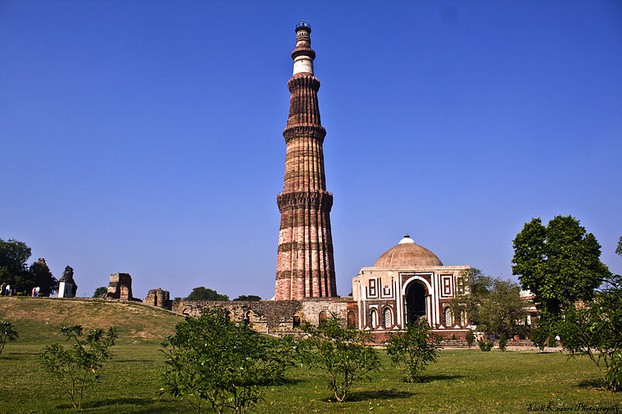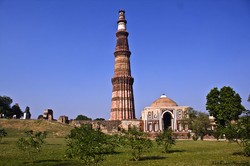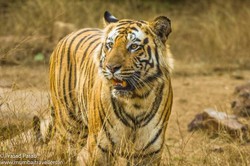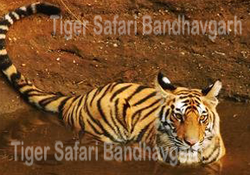Located in the vast flat plains of northern India is the city of Delhi. It divides into two sections, Old Delhi and New Delhi. From the 16th to the 19th centuries, Old Delhi was the capital of the Mughal Empire in India. New Delhi was built by the British Raj as the new capital of India in 1911 and it remains the capital of modern India today. In this article we will explore some of the great tourist attractions of Delhi.

Delhi: India's Capital City
Delhi is northern India's largest city. It comprises Old Delhi, the old Mughal capital of India, and New Delhi, a new area developed by the British and now modern India's capital.
New Delhi
New Delhi is the capital of India. An announcement was made by King George V in 1911 that the capital of British India was moving from Calcutta (now known as Kolkata) to Delhi and that a new area would be constructed for this capital (to be known as New Delhi). New Delhi was built according to the plans of Edward Lutyens and Herbert Baker, two leading British architects. Construction of this imperial capital was completed in 1931.
Today's New Delhi forges toward the future. It hosted the 2010 Commonwealth Games. It has a brand new metro (suburban railway system). It is not just a hub of government and administration, but increasingly a rising business and financial center.
Rajpath: A central feature of the design was the avenue known as Rajpath (or King's Way) which from India Gate (India's war memorial to the dead of various wars) at one end to the Viceroy's House (now known as Rashtrapati Bhawan and serving as the official residence of India's head of state) at the other. The Secretariat building with various government ministries and the Parliament House are located close by Rajpath. Another avenue, Janpath (literally, "people's way") connects at right angles with Rajpath and runs across to Connaught Place.
Connaught Place: Now officially renamed as Rajiv Chowk (or "Rajiv Market") in honor of former Prime Minister Rajiv Gandhi, Connaught Place (often termed just "CP") is one of Delhi's top financial and business centers. Its Georgian architecture forms and almost complete circle design. In the early years the patrons of CP were mainly British officials and Indian princely families. Upmarket restaurants, theaters, and clothes and furnishing shops catered to this clientele. New Delhi's first luxury hotel, the Imperial Hotel, is nearby. Today CP is famous for its restaurants, bars and bookshops.
Humayun's Tomb: This is the beautiful tomb of the Mughal Emperor Humayun (1508-56). It was the first garden-tomb in the Indian subcontinent and it is the first example in the subcontinent of the utilization of red sandstone and of marble on a large scale. The surrounding garden was built using the Charbagh layout (a Persian quadrilateral design of "Paradise garden" -- in which the garden was divided into four sections separated by walkways or water courses -- never before used in India). The garden tomb design of Humayun's Tomb was to greatly influence the development of later Mughal architecture in India, for example, the Taj Mahal. Humayun's Tomb has been declared a UNESCO World Heritage Site.
Qutub Minar: The Qutub Minar was constructed as a Victory Tower to celebrate the victory of Mohammed Ghori in 1192. It is the world's highest brick minaret (over 72 meters high), with an exterior of fluted columns surmounted with a veneer of red and buff sandstone. These fluted columns are surrounded by bands which are inscribed with exquisite and intricately carved quotations from the Islamic scriptures. The Qutab Minar is also a UNESCO World Heritage Site.
Nearby are the Quwwat-ul-Islam mosque, a number of tombs and the celebrated Iron Pillar of Delhi. This iron pillar, which weighs over six tons, dates from the Gupta era or somewhat later, and is remarkable for its remarkable resistance to corrosion over many centuries. The corrosion is said to have been just one twentieth part of a millimeter thick over all of that time -- which is, according to the Indian scholar, R. Balasubramaniam, "a living testimony to the skill of metallurgists of ancient India".
Other attractions in New Delhi worth seeing are:
-- the Jantar Mantar (or Yanta Mantra), one of a series of five astronomical observatories built between 1727 and 1734 by the Maharaja Jai Singh II and which were built to predict eclipses and similar astronomical phenomena
-- the beautiful and serene Lodi Gardens, dating from the 15th and 16th centuries.
Hamayun's Tomb, New Delhi
 Hamayun's Tomb Michael Hoefner |
Qutub Minar, New Delhi
 Qutub Minar, New Delhi Cool sneh13 |
Old Delhi
Old Delhi was the capital of the Mughal Empire (a series of Muslim emperors who descended from the two great conquerors, Genghis Khan and Tamerlane) which ruled much of the Indian subcontinent (much of modern-day northern India, Bangladesh, northern Pakistan and part of Afghanistan) from 1526 until 1858.
Chandni Chowk: The Chandni Chowk (meaning "moonlit market" in the Urdu language) is one of the oldest markets in Delhi. It was built in the 17th century by the Mughal Emperor, Shah Jahan, to a design by his daughter, Jahan Ara Begum Sahib, in the old walled city of Old Delhi, then called Shahjahanabad (which also contained Red Fort). Chandni Chowk ran through the center of the walled city. A canal ran down the middle of the street brought a water supply to the residents of the city.
Chandni Chowk was once the grandest of markets. These days the market is quite crowded but its historical character can still be seen with centuries-old mosques, temples, churches and mansions still standing there. There is a huge variety of markets and shops (not a few of them more than 200 years old) which sell everything from sarees and embroidery, every sort of consumer goods and all kinds of Indian foods (including sweets, spices and other delicacies) down the wide Chandni Chowk streets and in the maze of narrow lanes (galis) of the market.
Jama Masjid: The Jama Masjid is the main mosque in Old Delhi and the largest mosque in India. The courtyard of the mosque can hold a massive crowd of 25,000 worshippers. The mosque was built in 1644-58 by Shah Jahan who was later to build the Taj Mahal.
Red Fort: Known in Urdu as "Lal Qila", this massive fort was built over a ten year period (1638-48) by the Mughal emperor Shah Jahan inside the walled city of Shanjahanabad (now Old Delhi). It was the residence of the Mughal emperors until the end of the Mughal Empire in 1857. Red Fort is truly huge in size, occupying an area of 121 acres. It is now a UNESCO World Heritage site.
Inside the Red Fort are halls, private apartments, women's quarters and a mosque. Built to an extremely high level of artistic and decorative skill, the design is a mix of Persian, European and Indian styles. In the Diwan-i-Khas ("hall of royal audience") where the emperor used to give private audiences to courtiers and state guests, there used to be the celebrated Peacock Throne and a silver ceiling (both now long since removed or looted).
Raj Ghat: The Raj Ghat is the black marble platform that marks the place on the banks of the Yamuna River where the father of modern India, Mahatma Gandhi, was cremated on January 31, 1948, the day after his assassination. An eternal flame burns at one end of the platform.
Chandni Chowk, Old Delhi
 Chandni Chowk, Old Delhi BazaNews |
Delhi on the Internet
Delhi
Delhi as it was in around the year 1880.
More India articles
You might also like
How Tiger Tourism is Organized in India?India is home to more than fifty percent of the World's tigers. The criticall...
How to Enjoy Wildlife at Kanha National Park?This is an article about Kanha National Park situated in Central India in the...









 Ancient Rome: History and Heritageon 02/28/2012
Ancient Rome: History and Heritageon 02/28/2012
 Ancient Greece: History and Heritageon 10/14/2012
Ancient Greece: History and Heritageon 10/14/2012
 Schumann: The Genius Who Composed Scenes From Childhoodon 04/29/2012
Schumann: The Genius Who Composed Scenes From Childhoodon 04/29/2012
 Mahler: The Genius Who Composed the Resurrection Symphonyon 03/04/2012
Mahler: The Genius Who Composed the Resurrection Symphonyon 03/04/2012



Comments
Such a fascinating place! Well done, DavidPaulWagner! Thanks for sharing!
The good news, Sheri, is that there is *always* another time! :)
I didn't realize there was more to Delhi than the wonderful colourful market. I didn't go anywhere other than my hotel (in the market area) to the fascinating shops and back to the hotel until it was time to head out for the airport (that was after visiting other places in India). For me, Delhi was the market. Guess I have to go back and see some of the other tourist sites. (If I don't get caught up in the market again, that is)
Thanks, Mladen! I have been to India several times and always had a wonderful time.
Oh, India is wonderful country! It is simple one of the destinations one must visting in his lifetime. I didn't visit it yet, but I have it in plan. I met few people from India, and they were very pleasant. I think Indians are great hosts. That was my impression speaking with these guys. Great article on Delhi, India!